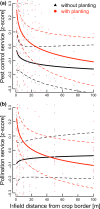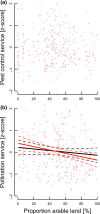The effectiveness of flower strips and hedgerows on pest control, pollination services and crop yield: a quantitative synthesis
- PMID: 32808477
- PMCID: PMC7540530
- DOI: 10.1111/ele.13576
The effectiveness of flower strips and hedgerows on pest control, pollination services and crop yield: a quantitative synthesis
Erratum in
-
ADDENDUM.Ecol Lett. 2021 Aug;24(8):1738. doi: 10.1111/ele.13748. Epub 2021 Apr 27. Ecol Lett. 2021. PMID: 33982412 Free PMC article. No abstract available.
Abstract
Floral plantings are promoted to foster ecological intensification of agriculture through provisioning of ecosystem services. However, a comprehensive assessment of the effectiveness of different floral plantings, their characteristics and consequences for crop yield is lacking. Here we quantified the impacts of flower strips and hedgerows on pest control (18 studies) and pollination services (17 studies) in adjacent crops in North America, Europe and New Zealand. Flower strips, but not hedgerows, enhanced pest control services in adjacent fields by 16% on average. However, effects on crop pollination and yield were more variable. Our synthesis identifies several important drivers of variability in effectiveness of plantings: pollination services declined exponentially with distance from plantings, and perennial and older flower strips with higher flowering plant diversity enhanced pollination more effectively. These findings provide promising pathways to optimise floral plantings to more effectively contribute to ecosystem service delivery and ecological intensification of agriculture in the future.
Keywords: Agroecology; agri-environment schemes; bee pollinators; conservation biological control; ecological intensification; farmland biodiversity; floral enhancements; natural pest regulation; pollination reservoirs; sustainable agriculture; wildflower strips.
© 2020 The Authors. Ecology Letters published by John Wiley & Sons Ltd.
Figures





References
-
- Albrecht, M. , Duelli, P. , Müller, C. , Kleijn, D. & Schmid, B. (2007). The Swiss agri‐environment scheme enhances pollinator diversity and plant reproductive success in nearby intensively managed farmland. J. Appl. Ecol., 44, 813–822.
-
- Bartomeus, I. , Gagic, V. & Bommarco, R. (2015). Pollinators, pests and soil properties interactively shape oilseed rape yield. Basic Appl. Ecol., 16, 737–745.
-
- Bates, D. , Maechler, M. , Bolker, B. , Walker, S. , Christensen, R.H.B. , Singmann, H. et al (2015). Package ‘lme4’. Convergence, 12 . Available at: https://cran.r‐project.org/web/packages/lme4/lme4.pdf. Last accessed 20 January 2020.
Publication types
MeSH terms
Grants and funding
- DEB 1832042/National Science Foundation Long-term Ecological Research Program
- University of Maine School of Biology and Ecology
- Michigan State University AgBioResearch
- Hauser and Sur-La-Croix foundations
- Tertiary Education Commission through the Bio-Protection Research Centre at Lincoln University, New Zealand
- Great Lakes Bioenergy Research Center, U.S. Department of Energy, Office of Science, Office of Biological and Environmental Research
- FA1307 "SUPER-B"/EU COST
- EU FP7
- WT_/Wellcome Trust/United Kingdom
- USDA Sustainable Agriculture Research and Education program
- 1518739/Biotechnology and Biological Sciences Research Council (BBSRC) and Syngenta UK
- AgBioResearch
- BB/P003664/1/SMOOPS project funded by BBSRC, Worldwide Fruit Limited, Avalon and Syngenta
- IUT36-2/Estonian Research Council Institutional Research Funding project
- 2011-51181-30673/United States Department of Agriculture - National Institute of Food and Agriculture Specialty Crops Research Initiative
- BB/1000348/1/Insect Pollinators Initiative UK Crop pollination project funded by BBSRC, Defra, NERC, the Scottish Government and the Wellcome Trust
LinkOut - more resources
Full Text Sources
Other Literature Sources

